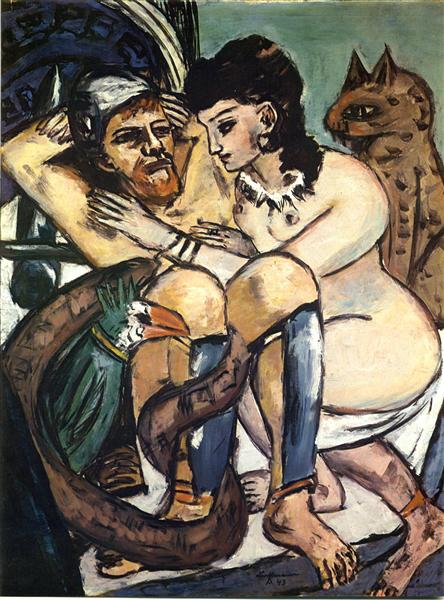Description
The work "Odysseus and Calipso" by Max Beckmann, painted in 1943, is a masterful example of the artist's ability to convey complex emotions through his intense color palette and his expressionist style. In this painting, Beckmann explores the theme of the soul's odyssey, using the mythological figure of Odysseus, who represents not only heroism and adventure, but also the internal struggle between desire and duty. Next to him, the figure of Calipso symbolizes seduction and beauty, offering a palpable contrast between the aspirations of a hero and the ties that keep him captive.
The composition is characterized by a dynamism that catches the viewer's attention. The figures are organized in a compressed space, which reinforces the tension inherent in the scene. Odysseus, represented with an expression that mixes contemplation and resistance, seems to be caught in an emotional dilemma. Its position and gestures suggest a yearning for freedom, while around it, the environment is perceived as a closed and oppressive space, which reflects the limitations it faces.
The color plays a fundamental role in the work. Beckmann uses vibrant and contrasting tones, with predominance of blue, which evoke both the immensity of the sea and the melancholy of the hero. Red and yellow nuances provide energy and emotional depth, creating an atmosphere loaded with drama. Each brushstroke seems to be impregnated with the duality of human experience: hope and despair, love and loss.
The representation of the characters is another key aspect of the work. Calipso, with his voluptuous figure and his enveloping gaze, attracts Odysseus's attention, symbolizing a temptation that moves him away from his home and his trip to Ithaca. The way Beckmann portrays Calipso suggests a mixture of desire and danger, reflecting the complexity of his relationship with Odysseus. Through Questo, the artist invites the viewer to consider not only the myth, but also the depths of human experience related to choice and sacrifice.
"Odysseus and Calipso" is representative of Beckmann's style, who stood out for his particular way of expressing existential anguish and the fight of the individual against crushing realities. His work is within the expressionist movement, which sought to convey raw and authentic emotions through an unnaturalist approach. A parallel can be found in other works of the twentieth century that address issues of alienation and search for meaning, such as paintings by Edvard Munch or the portraits of Egon Schiele.
In this sense, painting never ceases to be current. Although its production is in a historical context in which Europe faced the horrors of war, the individual's struggle for emotional and spiritual survival transcends time. With "Odysseus and Calipso", Max Beckmann not only captures a mythological narrative, but also raises a reflection on the desire, freedom and sacrifices that are often required on the road to self -awareness. It is a work that continues to resonate, inviting each spectator to embark on their own personal odyssey.
KUADROS ©, a famous paint on your wall.
Hand-made oil painting reproductions, with the quality of professional artists and the distinctive seal of KUADROS ©.
Art reproduction service with satisfaction guarantee. If you are not completely satisfied with the replica of your painting, we refund your money 100%.

